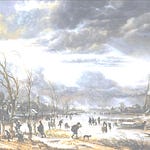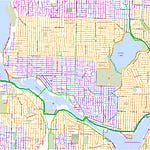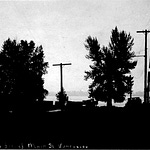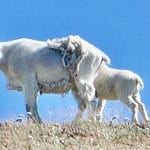Few natural story tellers are better than snow. Or more ephemeral. I was lucky enough to read some of the stories told by snow in Seattle’s recent snowmageddon. For those not from my fair city, we got about 2 inches of the white stuff or enough to cause general panic and chaos. Steep hills, a lack of equipment to deal with snow, and over confident drivers are not a good recipe for safe travel. One year, the lack of preparation for snow even led to the political demise of our mayor.
Taking advantage of the snow, I walked down to Green Lake, a small body of water about ten minutes south of our house. Although I saw few people there, those who came before had left their tracks in the snow. In fact, I was disappointed by the traces they had produced. I always find a simple pleasure in being the first to track across snow and these rascals had beaten me to it. But, in doing so, the snow tracks told a story that surprised me: more people get out early in the day than I realized. (As an early morning runner, I am used to not seeing people but in my ignorance, I hadn’t a clue that I was not alone.)
Not surprisingly animals tracks were everywhere. Small hops left by juncos. The steady gait of crows, some of which ended in a double-footed track as the bird leapt into flight. The leaping liquid jumps of squirrels; at our house their tracks revealed how they snuck through our fences. The two-inch-long and -wide, webbed-W of Canada geese. In a few places, the tracks entered the water. I could then, and this quite pleased me, follow the birds as they paddled through the slushy water. Looking out across the lake, I could see dozens of what I call qinnutrails, left by numerous birds plying their way through the oatmealy water.
Seeing the various tracks on land reminded me of something I read many years ago: researchers could track polar bears using infrared. As bears walked through snow, the pads of their feet released heat, which could be seen with infrared imagery. Turns out though this doesn’t really work because the heat dissipates too quickly in the Arctic cold. (I guess you cannot always trust what you read or remember reading.) What is more amazing though is that researchers are now able to collect skin cells shed from polar bear foot pads in their paw prints. With that information (termed e-DNA, or environmental DNA), it is possible to identify individual polar bears and their sex. This non-invasive information can then be used to make better management decisions, which are becoming ever more critical with climate change.
A week prior to snowmaggedon, while biking on the Centennial Trail with my pal Scott, I had a chance to read other stories in the snow. These were not written by animals but by the sun. Riding along, I was perplexed by where snow was and wasn’t. In some places, snow covered one side of the trail and not the other, or would end in a straight line, as if a wall had been in place when the snow fell. In other spots, the snow on the ground looked patternless. As I thought about it, I realized that I was seeing a pattern not of snow fall but of snow melt.
I didn’t figure this out immediately because the day we rode was completely overcast and gray; no sunlight illuminated either the land or my brain. The previous day had been sunlit and wherever it had pierced through foliage, it had melted the snow. This was the pattern I was seeing. I admit that this isn’t terribly earth shattering (fortunately) but I also know that I was happy and pleased with myself for linking what I saw with the natural phenomena that caused it.
As a writer focused on the natural world, I am always looking for connections—across time, across space, across disciplines. I do so because these connections further my links to and love for the place I call home. Taking the time to appreciate the world around me further centers me and rejuvenates me. And, it’s just plain fun. If I hadn’t been paying attention, I wouldn’t have had the pleasure of solving this little mystery written in snow.
Word of the Week - Qinnu is an Inuktitut term from the area around Kinngait (formerly known as Cape Dorset) in the Canadian Arctic. In a 2005 paper by Dr. Gina Ljubicic and based on extensive interviews, she defined qinnu as “early stage of ice formation, a slushy consistency in the water, the ice particles are soft and never really freeze.” Although based on salt water, it seems an appropriate word for the slush at Green Lake. A similar slushy phase of water is known as frazil ice, which would lead to fraziltrails, also a fine term.
Honored to be quoted in the Seattle Times in this pre-Valentine’s Day story about a giant sloth.
The Bottom Line - A few political thoughts.
Send your pennies to the White House; give them something to keep them busy.
One of the smarter people I know is my friend Howie Frumkin. Former Dean of the UW School of Public Health, he has been working on and writing about the benefits of nature for human health and well-being for many years. Unfortunately, due to the short sightedness of our president, a major, cross disciplinary report that Howie had been working on was canceled. Here’s an interview with Howie from KUOW. When will the present administration realize that we need to listen to and learn from the natural world around us?















Share this post